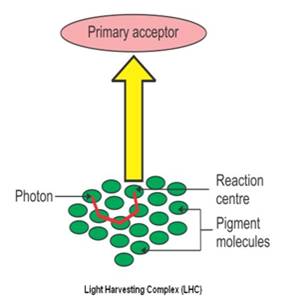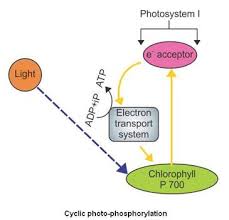These are the group pigments molecules which take part in the conversion of light energy into the chemical energy. The photosynthetic units are called Photosystem I (PS-I) and Photosystem II (PS-II). Each unit has a reaction centre of a specific chlorophyll a molecule which absorbs light energy of long wavelength. These centre can release electron upon absorption of energy. In PS-I, the reaction centre chlorophyll a has an absorption peak at 700 nm, hence is called P700, While in PS-II, reaction centre has an absorption maxima at 680 nm and is called P680

Reaction centre is surrounded by number of light harvesting pigment (LHP) molecules. These are also called antenna molecules. These absorb photons of different wavelength and transfer this energy to reaction centre. Harvesting molecules occurs in the form of specific complexes called light- harvesting complexes (LHC) called LHC-I and LHC-II. The pigments molecules of these complexes are bound to proteins. These help to make photosynthesis more efficient.
→ Reaction centre (P700)
PS-I–→ →LHP
→ LHC- I–→→
→ Proteins
→ Reaction centre (P 680)
PS-II → →LHP
→ LHC-II–→→
→Proteins
Some of the important differences between the two photosystems are:-
Photosystems I / pigment system I | Photosystems II / pigment system II |
1. The reaction centre is P700 | 1. The reaction centre is P680 |
2. PS I lies on the outer surface of the thylakoids | 2. PS II occurs on the inner surface of the thylakoids. |
3. Found in both grana and stroma lamellae. | 3. Found in grana lamellae only.
|
4. Participates in both cyclic as well as non-cyclic flow of electrons. | 4. It is involved only in non-cyclic flow of electrons. |
5. Not associated with splitting of water. | 5. Associated with splitting of water and release of O2. |
photosynthetic unit
MECHANISM OF PHOTOSYNTHESIS:-
Photosynthesis occurs in two phases
(a) Light reaction:- Solar energy is trapped by chlorophyll and stored in the form of chemical energy (ATP) and as reducing power (NADPH)
(b) Dark reaction:– Reducing capacity of NADPH and the energy of ATP are utilized in the conversion of CO2 to carbohydrates
Electron transport chain is a series of electron carriers over which electrons pass in a downhill journey releasing energy at every step that is used in generating an electrochemical proton gradient which helps in synthesizing ATP.
Based on path of electron, associated photophosphorylation can be identified as non-cyclic and cyclic photophosphorylation.
Non-cyclic photophosphorylation
It is involves both photosystem I and photosystem II. These two photosystem work in series, first PS II and then PS I. The two photosystems are connected through an electron transport chain. Both ATP and NADPH + H+ are synthesized by this kind of electron flow.
First in PS II, the P680 molecule absorbs 680 nm wavelength of red light causing electrons to become excited and jump into orbit which is farther from the atomic nucleus.

These electrons are picked up by an electron acceptor which passes them to an electron transport system of cytochromes. This movement of electrons is downhill on redox potential scale. This electrons are then passed onto the pigments of PS I, without being used as they pass through the electron transport chain. Simultaneously, electrons I the reaction centre of PS I (P700) are excited when they receive light of wavelength 700 nm and these electron are transferred to another acceptor molecule that has a greater redox potential. These electrons are then moved downhill again to a molecule of NADP+ to NADPH + H+ .
The whole scheme of transfer of electrons, starting from the PS II, uphill to the acceptor, down the electron transport chain to PS I, excitation of electrons, transfer to another acceptor and finally downhill to NADP+ reducing it to NADPH + H+ is called Z-scheme. The shape is formed when all the carriers are placed in a sequence on a potential scale.
The electrons that were removed from PS II must be replaced. This is achieved by electrons available due to splitting of water, The water splitting complex is associated with the PS II, which itself is physically located on the inner side of the membrane of the thylakoid. Water is split into H+ , [O] and electrons. The protons and oxygen formed by splitting of water is released within the lumen of the thylakoids. The oxygen produced is released as one of the net products of photosynthesis.
2H2 4H+ + O2 + 4e–
Cyclic photophosphorylation:-
The process of cyclic photophosphorylation involves only PS I and this process takes place in the stroma lamellae membrane. When only PS I is functional, the electron is circulated within the photosystem and the phosphorylation occurs, due to to cyclic flow of electrons.
The membrane or lamella of the grana have both PS I and PS II, the stroma lamella membranes lack PS II as well as NADP reductase enzyme The excited electron does not pass on to NAdP+ and is cycled back to the PS I complex through the electron transport chain. Cyclic photophosphorylation also occurs when only light of wavelength beyond 680 nm are available for excitation.
Some important differences between Cyclic and non-cyclic photophosphorylation are as follows:-
Cyclic photophosphorylation | Non-cyclic photophosphorylation |
1. It is performed by photosystem I independently | 1. It is performed by collaboration of both photosystems II and I |
2. An external source of electrons is not required | 2. The process requires an external electron donor |
3. It is not connected with photolysis of water, Therefore, no oxygen evolved. | 3. It is connected with photolysis of water and liberation of oxygen occurs. |
4. It synthesizes ATP only. | It is not only connected with ATP synthesis, but also with production of NADPH. |
5. It operates under low light intensity, anaerobic conditions or when CO 2 availability is poor. | 5. Non-cyclic photophosphorylation takes place under optimum light, aerobic conditions and in the presence of carbon dioxide. |
6. The system does not take part in photosynthesis except in certain bacteria. | 6. The system is connected with CO2 fixation in green plants. |
7. It occurs mostly in stroma lamellae membrane. | 7. It occurs in the granal thylakoids. |
